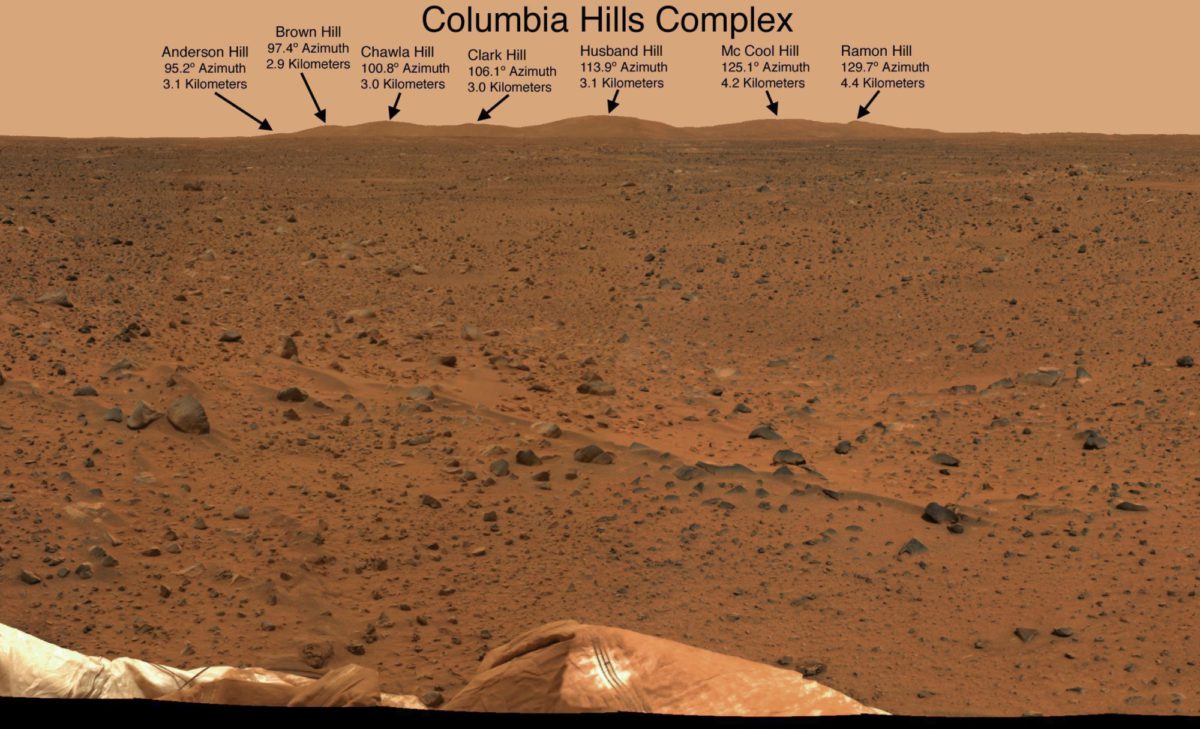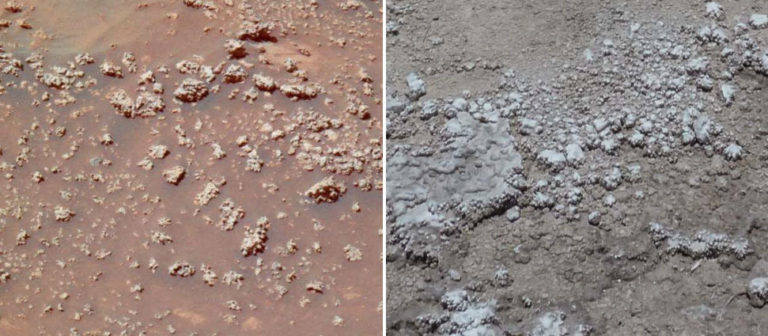Alex Longo • Oct 23, 2015
Why Return to the Columbia Hills?
Where should NASA’s next Mars rover, the Mars 2020 sample caching mission, land? This question has come up in some form at virtually every Mars-related meeting this year. The powerful Mars Reconnaissance Orbiter (MRO), with its high-resolution imaging system and mapping spectrometer, has been busy gathering data on nearly 30 candidate landing sites. The choice has significance beyond 2020, because the Mars 2020 landing site will host a series of future sample return missions.
One site under consideration is the Columbia Hills. Located in Gusev Crater, the hills are named for the astronauts of the Space Shuttle Columbia STS-107 mission. The Mars Exploration Rover Spirit studied them from 2004 to 2011. Launched on what was supposed to be a three-month mission, Spirit dramatically exceeded its lifetime, making many scientific discoveries along the way and persevering through seemingly impossible odds. The historic mission became an inspiration to children worldwide, including me. I am 15 years old, and Spirit was the mission that inspired my love for space exploration. The rover, which seemed almost human to my generation, was an inspiration and a positive role model to us.

Why revisit a site that's been explored before? There have been only seven successful Mars landings, and the planet is huge; shouldn't Mars 2020 go to a novel site? But "go to a novel site" is not one of the Mars 2020 mission's science goals. Spirit went to the Columbia Hills to search for evidence that water influenced the geology of ancient Mars. The Mars 2020 mission and goals are different. Mars 2020 is being designed to investigate a geologically diverse and habitable environment, to search for direct evidence of ancient life, to assemble a cache of samples for a future mission to return to Earth, and to prepare for human exploration of Mars.
To accomplish the habitability investigation, Mars 2020 will need access to a variety of minerals formed in ancient aqueous environments. The geologic diversity present in the tiny 3 by 5 kilometer footprint of the Columbia Hills is astounding: Clays, carbonate minerals, and sulfates all formed in either ancient, long-lasting lakes or in more recent, ephemeral lakes of varying salinity. Rock outcrops made out of nearly pure silica are evidence of an ancient hydrothermal system. Sampling the extensive volcanic basalts present will allow the age of the planet’s surface to be determined. This in turn could shed light on how the solar system formed.
New research by a team led by Dr. Steve Ruff also suggests that the Columbia Hills would be an excellent place to look for evidence of ancient life on Mars—the second major Mars 2020 mission objective. A hydrothermal system, such as that present in the Columbia Hills, has long been suggested as a niche where the molecules required for early life could have been assembled. The silica deposits discovered by Spirit on Mars bear a remarkable similarity to silica deposits found in the El Tatio hydrothermal field in Chile, an arid, Mars-like environment. The El Tatio outcrops have nodular shapes potentially associated with a biological origin, and they are teeming with microbial life. The ground truth from Spirit, coupled with a known analog environment on Earth, could make this hydrothermal system a good place to begin our dedicated search for past life on the surface of Mars. If we explore this ancient environment with a more modern instrument suite, could we answer the timeless question, “Are we alone in the universe?” It is possible.

The Mars 2020 rover’s reason for being is to collect up to 30 diverse and exobiologically relevant samples to be returned to Earth with the objective of answering questions about astrobiology and planetary evolution. The compact and geologically rich Columbia Hills allow such a cache to be assembled from rocks and minerals identified for potential past habitability by Spirit. The Columbia Hills also meet the objectives for a Mars 2020 landing site because they are safe. The landing site is free of large obstructions and has a known topography, allowing the rover’s time to be spent doing science immediately rather than driving to distant regions of interest.
The Columbia Hills also satisfy the fourth Mars 2020 science goal—to prepare for human exploration—with its extensive geologic diversity. There is a unique opportunity provided by having access to the defunct Spirit rover. By imaging Spirit on the surface, we would, as suggested by Dr. Jim Rice, learn something important about how hardware ages in the Martian environment. The last thing we would want once a Mars base is built is for a critical component to fail, leaving the astronauts stranded. By imaging Spirit, we can learn which components of a machine survive the test of time on Mars, and which do not.
The Columbia Hills feature a safe landing site with the potential for satisfying the highest-priority objective in the decadal survey, an extremely diverse geologic history, a potential abode for past life within an ancient hydrothermal system, and a unique opportunity to prepare for human exploration by understanding how hardware ages in the Martian environment. Perhaps the question is not “Why return to the Columbia Hills?” but “Why not?”

Let’s Go Beyond The Horizon
Every success in space exploration is the result of the community of space enthusiasts, like you, who believe it is important. You can help usher in the next great era of space exploration with your gift today.
Donate Today

 Explore Worlds
Explore Worlds Find Life
Find Life Defend Earth
Defend Earth

